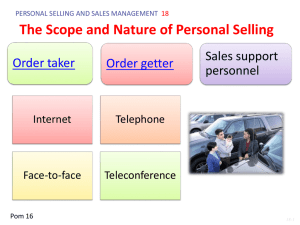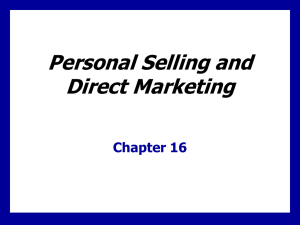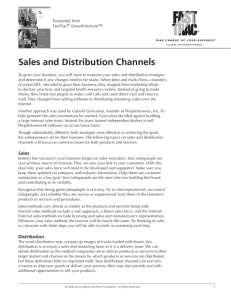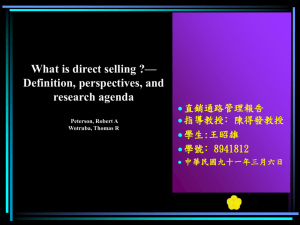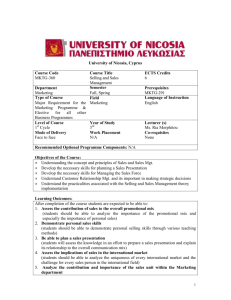Personal Selling & Direct Marketing - UoM
advertisement
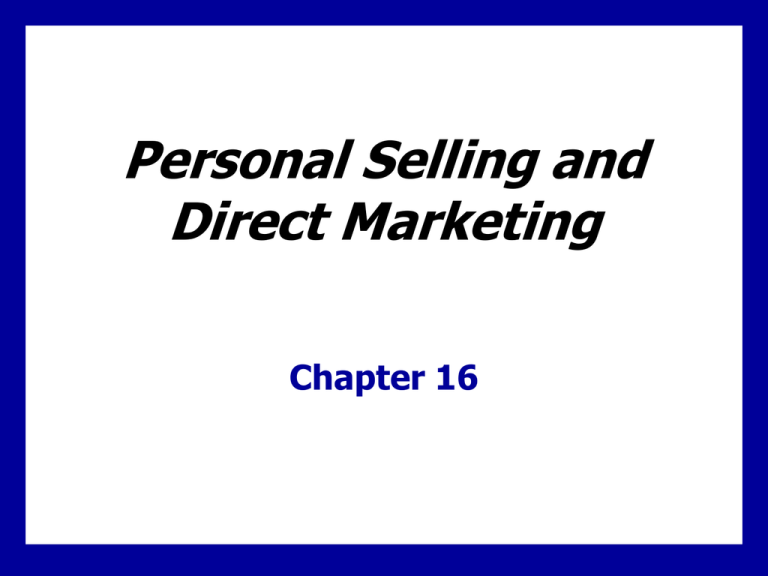
Personal Selling and Direct Marketing Chapter 16 Learning Goals 1. 2. 3. 4. 5. Understand the role of a company’s salespeople in creating value. Know the six major sales force management steps. Understand the personal selling process, and how to distinguish between transaction-oriented marketing and relationship marketing. Learn about direct marketing and its benefits to customers and companies. Know the major forms of direct marketing. 16 - 1 Case Study CDW Corporation • Nation’s largest reseller of technology products and services to small and mid-size businesses • Sales up 21% and profits up 17% annually • Highly devoted to customer with “Circle of Service” philosophy • Clicks and people direct marketing strategy combines personal selling with strong Web presence • Salespeople are highly knowledgeable • Training is extensive 16 - 2 Personal Selling The Nature of Personal Selling Salesperson covers a wide range of positions from order taker to order getter responsible for relationship building 16 - 3 Goal 1: Understand the role of the salespeople in creating value Personal Selling Salespeople Have Many Names • Agents • Sales Consultants • Sales Representatives • Account Executives • Sales Engineers • District Managers • Marketing Representatives • Account Development Representatives 16 - 4 Goal 1: Understand the role of the salespeople in creating value Personal Selling The Role of the Sales Force Two-way personal communication More effective than advertising in complex selling situations The sales force plays a major role in most companies The sales force represents the company to customers They also represent the customers to the company 16 - 5 Goal 1: Understand the role of the salespeople in creating value Definition Sales Force Management The analysis, planning, implementation, and control of sales force activities Goal 2: Know the six major sales force management steps 16 - 6 Managing the Sales Force Sales Force Strategy and Structure Sales Force Structure • • • • Territorial sales force structure Product sales force structure Customer sales force structure Complex sales force structure Goal 2: Know the six major sales force management steps 16 - 7 Managing the Sales Force Sales Force Strategy and Structure Sales Force Size • Many companies use the workload approach to set sales force size Other Issues • Outside and inside sales forces • Team selling Goal 2: Know the six major sales force management steps 16 - 8 Managing the Sales Force Recruiting and Selecting Salespeople Careful recruiting can: • Increase overall sales force performance • Reduce turnover • Reduce recruiting and training costs Goal 2: Know the six major sales force management steps 16 - 9 Managing the Sales Force Traits of Successful Salespeople • • • • Intrinsic motivation Disciplined work style The ability to close a sale Ability to build relationships with customers Goal 2: Know the six major sales force management steps 16 - 10 Managing the Sales Force Training Salespeople Training period can be anywhere from a few weeks to a year or more Training is expensive, but yields strong returns Training programs have many goals Many companies are adding Webbased sales training programs Goal 2: Know the six major sales force management steps 16 - 11 Managing the Sales Force Compensating Salespeople Compensation elements: salary, bonuses, commissions, expenses, and fringe benefits Basic compensation plans: • • • • Straight salary Straight commission Salary plus bonus Salary plus commission Compensation plans should direct the sales force toward activities that are consistent with overall marketing objectives. Goal 2: Know the six major sales force management steps 16 - 12 Managing the Sales Force Supervising Salespeople Effective supervisors provide direction to the sales force • Annual call plans and time-and-duty analysis can help provide direction • Sales force automation systems assist in creating more efficient sales force operations • The Internet is the fastest-growing sales technology tool Goal 2: Know the six major sales force management steps 16 - 13 Managing the Sales Force Supervising Salespeople Effective supervisors also motivate the sales force • Organizational climate • Sales quotas • Positive incentives – Sales meetings, sales contests, honors, etc. Goal 2: Know the six major sales force management steps 16 - 14 Managing the Sales Force Evaluating Salespeople Several tools can be used • Sales reports • Call reports • Expense reports Goal 2: Know the six major sales force management steps 16 - 15 The Personal Selling Process Prospecting and Qualifying Prospecting: identifying potential customers Qualifying: Screening leads Preapproach Learning as much as possible about a prospective customer prior to making a sales call Approach Stage where the salesperson meets the customer for the first time 16 - 16 Goal 3: Understand the personal selling process The Personal Selling Process Presentation and Demonstration Benefits of the product are presented/demonstrated Understanding prospect needs is key Handling Objections and Closing Asking for the order Follow-up Helps ensure customer satisfaction 16 - 17 Goal 3: Understand the personal selling process Definition Direct Marketing Consists of direct one-to-one connections with carefully targeted individual consumers to both obtain an immediate response and cultivate lasting customer relationships. 16 - 18 Goal 4: Learn about direct marketing and its benefits Benefits of Direct Marketing For Buyers: Convenient Easy to use Private Access to a wealth of information Immediate Interactive 16 - 19 Goal 4: Learn about direct marketing and its benefits Benefits of Direct Marketing For Sellers Powerful tool for building relationships Allows for targeting of small groups or individuals with customized offers in a personalized fashion Can be timed to reach prospects at the right time Offers access to buyers that couldn’t be reached via other channels Low-cost, effective alternative for reaching specific markets 16 - 20 Goal 4: Learn about direct marketing and its benefits Direct Marketing Customer Databases & Direct Marketing Databases include comprehensive data including geographic, demographic, psychographic and behavioral Databases can be used to identify prospects, tailor products, and maintain customer relationships Database marketing requires substantial investment in hardware, software, personnel 16 - 21 Goal 5: Know the major forms of direct marketing Direct Marketing Integrated Direct Marketing Public Policy and Ethical Issues Irritation, Unfairness, Deception, and Fraud Invasion of Privacy 16 - 22 Goal 5: Know the major forms of direct marketing


